Papers by M. Natividad Fuertes-Prieto

RESUMEN Se presenta una revisión de los datos disponibles sobre el uso de las materias primas lít... more RESUMEN Se presenta una revisión de los datos disponibles sobre el uso de las materias primas líticas adscritas al grupo del " sílex " desde un punto de vista arqueológico genérico y que han sido utilizadas en la talla lítica a lo largo de la Prehistoria en esta zona de la Cuenca del Duero. En este grupo se incluyen tanto los sílex pro-piamente dichos como cherts y radiolaritas, además de algunas pizarras sensu lato. Se realiza una evaluación de la base geológica potencial con el fin de determinar las áreas de aprovisionamiento de estas distintas mate-rias. La revisión de su presencia en contexto arqueológico permitirá acercarnos a la gestión de estos recursos líticos a lo largo de la Prehistoria meseteña. ABSTRACT This study presents a re-analysis of the available data on the use of the group of raw materials catego-rised generally as 'flint' in archaeological research, and which were used for lithic knapping throughout prehistory in this area of the Duero River b...
The Archaeology of ‘Underdog Sites’ in the Douro Valley From Prehistory to the Modern Age Edited by Santiago Sánchez de la Parra-Pérez, Sonia Díaz-Navarro, Javier Fernández-Lozano and Javier Jiménez Gadea, 2021
The paper aims to present a preliminary report about a rescue excavation carried out in 1986 beca... more The paper aims to present a preliminary report about a rescue excavation carried out in 1986 because
of a chance find in Monte de La Candamia, near the city of León. It is a tomb in which human remains
belonging to 9 individuals were recovered, associated with knapped and polished lithic industry as a
whole baggage of material culture, dated to the beginning of the 3rd millennium BC. This archaeological
site, either in its exclusively funerary expression –a non-megalithic tomb bearing the tradition of
dolmenic collective burials– or as habitation sites, are extremely rare so far in the province of León,
where the Final Neolithic-Chalcolithic times are very poorly known.

Quaternary International, 2015
This study presents the main features of the lithic industry we have termed ‘Mesolithic with geom... more This study presents the main features of the lithic industry we have termed ‘Mesolithic with geometrics’. It has been observed at two cave sites, El Espertín and La Uña (levels III and IV), both located on the southern versant of the Cantabrian Range, and with chronologies ranging from the second half of the 7th millennium cal. BC to the end of the 6th millennium cal. BC. This work will focus on the characterization of the raw materials and the evaluation of their sourcing patterns. Also, a techno-typological study of the lithics, focusing on the retouched tools, will be presented. The two caves show a number of similarities, such as their altitude (more than 1200 m.a.s.l. in both cases) and their small size. As for the lithics, the raw materials used and the scarcity of geometrics are much the same, and they also share a lithic industry with deeply-rooted archaic features linked to the Upper-Palaeolithc/Azilian regional tradition.

Quaternary International, 2015
This study presents the main features of the lithic industry we have termed ‘Mesolithic with geom... more This study presents the main features of the lithic industry we have termed ‘Mesolithic with geometrics’. It has been observed at two cave sites, El Espertín and La Uña (levels III and IV), both located on the southern versant of the Cantabrian Range, and with chronologies ranging from the second half of the 7th millennium cal. BC to the end of the 6th millennium cal. BC. This work will focus on the characterization of the raw materials and the evaluation of their sourcing patterns. Also, a techno-typological study of the lithics, focusing on the retouched tools, will be presented. The two caves show a number of similarities, such as their altitude (more than 1200 m.a.s.l. in both cases) and their small size. As for the lithics, the raw materials used and the scarcity of geometrics are much the same, and they also share a lithic industry with deeply-rooted archaic features linked to the Upper-Palaeolithc/Azilian regional tradition.
Foraging Assemblages. Vol. 2 / edited by Dušan Borić, Dragana Antonović, and Bojana Mihailović., 2021
In this paper, we will briefly present data on raw material management of Mesolithic occupations ... more In this paper, we will briefly present data on raw material management of Mesolithic occupations south of the Picos de Europa, the highest peaks of the Cantabrian Mountains, located in the north of the Iberian Peninsula. Our raw material management study will focus on the cave sites of La Uña and El Espertín. Several
raw material varieties present at these two sites have been identified. This has enabled us to determine the raw material sourcing networks along the Cantabrian coast for these sites and identify their links with other areas. Lastly, these raw materials have been linked to the technology of the retouched industry noted at the
two aforementioned sites.
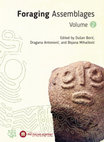
Foraging Assemblages. Vol. 2 / edited by Dušan Borić, Dragana Antonović, and Bojana Mihailović., 2021
The Mesolithic in northern Spain is usually characterized by the presence of large shell middens ... more The Mesolithic in northern Spain is usually characterized by the presence of large shell middens belonging to the so-called Asturian culture. Recent excavations at El Mazo rockshelter (2009–2015) provide new data for the discussion of technological questions. Although four test pits have been excavated, we will focus on parts of two test pits from the 2009–2010 campaigns. We present preliminary results of the study of the lithic assemblage from some of the Mesolithic levels, taking into account their raw materials, technology, and typology. The objective of this research is to increase our knowledge of the Mesolithic in northern Spain. The locally available lithic raw materials (chert and radiolarite) are the most abundant. As for the technology, there is a significant presence of small-sized lithics and the production of blade/bladelet supports. Among the retouched lithics, geometric armatures represent an important type. These results suggest a significant change from the dominant paradigm linked to the lithic assemblages of the Asturian culture.
Foraging Assemblages. Ninth International Conference on the Mesolithic in Europe (Belgrade, 2015),, 2021
The aim of this article is to outline archaeological and environmental evidence for the Mesolithi... more The aim of this article is to outline archaeological and environmental evidence for the Mesolithic in the north-west of the Iberian Peninsula (Galicia). The sites under study are the following: Xestido III, Paradero de Reiro, and Pena Lliboi. Xestido III and Paradero de Reiro are open-air sites found in peat bogs, while Pena Lliboi is a rockshelter. All three sites are found in different geographical environments: mountainous interior, Atlantic coast, and inland plain, respectively. In this paper, we present the study of the lithic assemblages from these sites taking into account raw materials, technology, and typology. We also present the results of faunal analyses and the paleoenvironmental context of these sites.

Journal of Archaeological Science: Reports, 2020
This paper presents an update of the known data on the lithic industries of the “Mesolithic with ... more This paper presents an update of the known data on the lithic industries of the “Mesolithic with geometrics”. From the information available in two caves, La Uña and El Espertín (León, Spain), located south of the Picos de Europa (in the central sector of the Cantabrian Mountains), the results of the different methodological approaches are presented: the raw materials used and the sources of supply of chert and flint, the main chaînes operatoires and their relationship with the raw materials and the relationship of the latter with the retouched industry. Finally, using local and regional outcrops, we propose the possible routes travelled by the human groups that occupied these caves between the north and the south of the Cantabrian Mountains.
Proximate local raw materials (less than 15 km) were exploited most, but some distant local types (15–30 km) were also directly acquired. Non local raw materials are significantly more frequent in La Uña than in El Espertín. Nevertheless, in both caves there are regional (30–120 km) and tracer (>120 km) chert and flint varieties that prove the connection between the south of the Cantabrian Mountains and the north (northwest and northeast), involving the coastal area in these relationships. The technological management of theses raw materials suggests some sort of planning in their territory wide procurement.
Apart from more flexible modalities for the production of blade and bladelets, good quality laminar blanks were obtained by pyramidal and prismatic unipolar modalities in chert and flint raw materials from local and regional lithologies. More diverse chains were applied to produce flakes, especially in local raw materials (and with a greater variability in El Espertín).
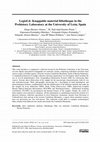
Journal of Lithic Studies, 2018
This work introduces a comparative collection located in the Prehistory Laboratory at the Univers... more This work introduces a comparative collection located in the Prehistory Laboratory at the University of León (Spain) specialised in knappable raw materials, mainly comprising radiolarite and black chert (micro-crypto crystalline quartz), from the western Cantabrian Mountains (north of Iberian Peninsula). A standardised protocol of sample collection and data organisation was developed, which includes the use of several methodologies. First, Geographical Information Systems (GIS) for referencing lithic sources. Second, direct observation of the sample for the macroscopic characterization, both de visu and stereomicroscope. Third, petrographic microscopy for a description of main petrological, and palaeontological features, complemented with the identification of the different minerals that make up the samples by X-ray diffraction (XRD). Forth, X-Ray Fluorescence (XRF), Inductively Coupled Plasma Optical Emission Spectrometry (ICP-OES) and Thermogravimetry-Differential Scanning Calorimetry (TG-DSC) for geochemical and thermal features of the samples. Finally, the results of these analyses were entered in a database. All this information is contributing towards the creation of a physical reference collection specialised in local Palaeozoic formations (mostly from Devonian to Carboniferous) that outcrop in the western Cantabrian Mountains, a region whose potential resource base was previously not very well known. This collection would allow to compare archaeological lithic remains from different sites inside and outside the Cantabrian Mountains.
Férvedes, 2018
The aim of this work is to present the lithic ensembles surveyed on three sites from the province... more The aim of this work is to present the lithic ensembles surveyed on three sites from the province of León (Spain) that are provisionally assigned to the Calcolithic. A general overview of the main tecno-typological features will be presented and also a macroscopic study of the lithic raw material. An approach to the lithic raw material procurement will be also outlined. Lastly, the topic of the problematical study of surface materials will be undertaken.
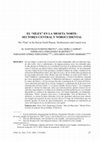
Cuadernos de Prehistoria y Arqueología de la Universidad de Granada, 2016
En este trabajo se realiza una revisión de los datos disponibles sobre los diferentes tipos de sí... more En este trabajo se realiza una revisión de los datos disponibles sobre los diferentes tipos de sílex (sílex, chert y radiolaritas) y de algunas pizarras sensu lato utilizados para la talla durante la Prehistoria en el cuadrante Noroeste de la Meseta Norte, entendida como el territorio que abarca toda la cuenca hidrográfica del Duero. Se ha comenzado con una evaluación de la base geológica, mediante trabajos de campo y análisis de las referencias bibliográficas sobre estos tipos de rocas y de las formaciones geológicas de las que pueden proceder. Estas últimas han sido divididas en cuatro áreas fuentes: 1) Zona Cantábrica, constituida por rocas sedimentarias; 2) Zona Centroibérica, formada por rocas metamórficas e ígneas; 3) Materiales paleógenos y neógenos que rellenan la cuenca del Duero; y 4) Las terrazas fluviales cuaternarias de la Cuenca del Duero, cuyos materiales proceden de la erosión, transporte y sedimentación de diversas rocas constituyentes del área fuente 3 y, en menor medida, del área fuente 1. En el siguiente apartado se valoran los datos que, sobre esas materias primas, pueden extraerse de los contextos arqueológicos a lo largo de los distintos periodos prehistóricos. Los estudios disponibles se centran en las siguientes rocas: chert negro (laminado y no laminado), radiolarita, " filitas " (pizarra sensu lato) y el denominado " sílex de Mucientes ". Fi-nalmente, se cruzan los datos obtenidos en los dos apartados anteriores para esbozar una imagen de la gestión de estos recursos líticos a lo largo de la Prehistoria que nos permita apuntar sus áreas de aprovisionamiento, sus estrategias de explotación así como un bosquejo de su circulación por esta región.
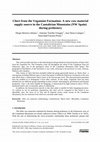
This work provides the keys to the mineralogical and geochemical characterization of black chert ... more This work provides the keys to the mineralogical and geochemical characterization of black chert from the Vegamián Fm. This formation crops out throughout the whole of the Cantabrian Zone (of Palaeozoic age), one of the geological zones of the Cantabrian Mountains (NW Spain). The geographical distribution of this formation is very wide, surfacing in the provinces of León, Asturias, Palencia and Cantabria. This variety of chert had been included within the group generically known as 'black chert', a macrogroup including different types of chert that appear in different Palaeozoic formations in the area and which share a characteristic black colour at the macroscopic level. The characterisation presented here has enabled us to distinguish it from other varieties. In this study, Vegamián chert has been divided into two different groups depending on their textural, mineralogical, geochemical and thermal propierties. Type 1, the most suitable for knapping, is characterized by high content in silica (>97%), laminated matrix and, occasionally, ghost of radiolarians. In addition, the characteristics specific to this chert make it suitable for lithic knapping processes. To confirm its use by prehistoric populations, this chert will be compared to that found in two Mesolithic sites, the caves of La Uña and El Espertín (León, south versant of the Cantabrian Mountains), the raw materials from which are currently under study.
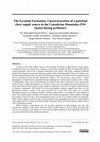
Journal of Lithic Studies, 2016
A study of the chert nodules found in the Escalada Formation (Carboniferous, Ponga region, Cantab... more A study of the chert nodules found in the Escalada Formation (Carboniferous, Ponga region, Cantabrian Zone) was carried out as a means to characterise a number of lithic raw materials found in several prehistoric sites of the Cantabrian Mountains (NW Spain). This study comprises fieldwork aimed at locating the outcrops and obtaining samples. Some selected samples from two localities were used for both petrological (macroscopic and microscopic analyses from thin sections) and geochemical (X-ray fluorescence and powder diffraction) analysis. The macroscopic study shows a rather homogeneus coloration and a conchoidal fracture although two extreme types of cherts with a variety of intermediate forms can be differentiated according to the matrix composition. The microscopic analysis shows a high heterogeneity in carbonate versus silica percentage and gentle differences in some other features such as type of silica, origin of carbonates, occurrence of organic matter and type of skeletal components. The results of several geochemical analysis suggest that there are not geochemical features neither in the major elements nor in the traces that allows us to clearly distinguish between the analysed samples. All these studies allow us to define the main features of these chert nodules and to establish several types and varieties among them. Those varieties with high percentage of silica and with a more homogeneous matrix are the most suitable samples for knapping. These results together with the study of the geological and geographical location of archaeological sites suggest that the nodules from the Escalada Formation likely were lithic material supply sources used in knapping activities
When aiming to demonstrate the use of these materials at archaeological sites the sole macroscopic analysis of the pieces does not suffice; further analyses, such as those involving thin sections, are necessary. The absence of chert from Escalada Formation in some Mesolithic sites in the area was confirmed via these additional analyses.
Pared norte de "La Cuevona". A) Galerías prehistóricas. B) Cavidad kárstica.

Quaternary International, 2016
This study presents the main features of the lithic industry we have termed ‘Mesolithic with geom... more This study presents the main features of the lithic industry we have termed ‘Mesolithic with geometrics’. It has been observed at two cave sites, El Espertín and La Uña (levels III and IV), both located on the southern versant of the Cantabrian Range, and with chronologies ranging from the second half of the 7th millennium cal. BC to the end of the 6th millennium cal. BC. This work will focus on the characterization of the raw materials and the evaluation of their sourcing patterns. Also, a techno-typological study of the lithics, focusing on the retouched tools, will be presented. The two caves show a number of similarities, such as their altitude (more than 1200 m.a.s.l. in both cases) and their small size. As for the lithics, the raw materials used and the scarcity of geometrics are much the same, and they also share a lithic industry with deeply-rooted archaic features linked to the Upper-Palaeolithc/Azilian regional tradition.
L. Grau Lobo (Coord.): Arqueoleón II. Historia de León a través de la arqueología. Actas del Ciclo de Conferencias (Museo de León, noviembre 2013 – marzo 2014). pp. 67-88.
Férvedes, 8: 45-54, 2015
This study presents a re-analysis of the available data on the use of the group of raw materials ... more This study presents a re-analysis of the available data on the use of the group of raw materials categorised generally as ‘flint’ in archaeological research, and which were used for lithic knapping throughout prehistory in this area of the Duero River basin. This group comprises flint or chert itself and radiolarites, as well as some slate sensu lato. A geological assessment is undertaken as part of this study with the aim of pinpointing the areas where these various raw materials were procured. The review of their presence within archaeological contexts will enable us to gain a better understanding of the kinds of raw-material management strategies in place in the Meseta throughout prehistory.
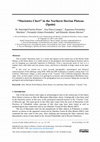
Journal of Lithic Studies, Vol 1 (1), 2014
"The so-called “Mucientes chert" is a variety that appears in the central area of the Iberian Nor... more "The so-called “Mucientes chert" is a variety that appears in the central area of the Iberian North Plateau, in theDueroBasin. It is widely known in the geological and archaeological literature and its use for knapping was especially important in Prehistory. From a macroscopic point of view it is a nodular chert, with white and very porous cortex, and brown to blackish or beige colour in the inner part.
In this work we carried out a more accurate petrographic, mineralogical and chemical characterization of this lithology using SEM, XRD and XRF techniques in samples coming from “Las Canteras” (Mucientes village), a chert outcrop of the “Cuestas” Unit (Vallesian-Aragonian, Miocene Age). Also, we have made a review of its geological occurrence and archaeological distribution areas. It is intended to sketch the delimitation of the geographical area of occurrence taking into account the geological and archaeological references. "
M.-Y. Daire et al. (Eds.): Ancient Maritime Communities and the Relationship between People and Environment along the European Atlantic Coasts. BAR International Series 2570, pp. 483-490., 2013


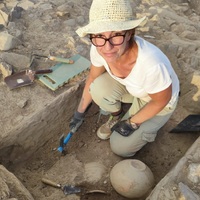






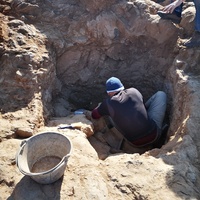
Uploads
Papers by M. Natividad Fuertes-Prieto
of a chance find in Monte de La Candamia, near the city of León. It is a tomb in which human remains
belonging to 9 individuals were recovered, associated with knapped and polished lithic industry as a
whole baggage of material culture, dated to the beginning of the 3rd millennium BC. This archaeological
site, either in its exclusively funerary expression –a non-megalithic tomb bearing the tradition of
dolmenic collective burials– or as habitation sites, are extremely rare so far in the province of León,
where the Final Neolithic-Chalcolithic times are very poorly known.
raw material varieties present at these two sites have been identified. This has enabled us to determine the raw material sourcing networks along the Cantabrian coast for these sites and identify their links with other areas. Lastly, these raw materials have been linked to the technology of the retouched industry noted at the
two aforementioned sites.
Proximate local raw materials (less than 15 km) were exploited most, but some distant local types (15–30 km) were also directly acquired. Non local raw materials are significantly more frequent in La Uña than in El Espertín. Nevertheless, in both caves there are regional (30–120 km) and tracer (>120 km) chert and flint varieties that prove the connection between the south of the Cantabrian Mountains and the north (northwest and northeast), involving the coastal area in these relationships. The technological management of theses raw materials suggests some sort of planning in their territory wide procurement.
Apart from more flexible modalities for the production of blade and bladelets, good quality laminar blanks were obtained by pyramidal and prismatic unipolar modalities in chert and flint raw materials from local and regional lithologies. More diverse chains were applied to produce flakes, especially in local raw materials (and with a greater variability in El Espertín).
When aiming to demonstrate the use of these materials at archaeological sites the sole macroscopic analysis of the pieces does not suffice; further analyses, such as those involving thin sections, are necessary. The absence of chert from Escalada Formation in some Mesolithic sites in the area was confirmed via these additional analyses.
In this work we carried out a more accurate petrographic, mineralogical and chemical characterization of this lithology using SEM, XRD and XRF techniques in samples coming from “Las Canteras” (Mucientes village), a chert outcrop of the “Cuestas” Unit (Vallesian-Aragonian, Miocene Age). Also, we have made a review of its geological occurrence and archaeological distribution areas. It is intended to sketch the delimitation of the geographical area of occurrence taking into account the geological and archaeological references. "
of a chance find in Monte de La Candamia, near the city of León. It is a tomb in which human remains
belonging to 9 individuals were recovered, associated with knapped and polished lithic industry as a
whole baggage of material culture, dated to the beginning of the 3rd millennium BC. This archaeological
site, either in its exclusively funerary expression –a non-megalithic tomb bearing the tradition of
dolmenic collective burials– or as habitation sites, are extremely rare so far in the province of León,
where the Final Neolithic-Chalcolithic times are very poorly known.
raw material varieties present at these two sites have been identified. This has enabled us to determine the raw material sourcing networks along the Cantabrian coast for these sites and identify their links with other areas. Lastly, these raw materials have been linked to the technology of the retouched industry noted at the
two aforementioned sites.
Proximate local raw materials (less than 15 km) were exploited most, but some distant local types (15–30 km) were also directly acquired. Non local raw materials are significantly more frequent in La Uña than in El Espertín. Nevertheless, in both caves there are regional (30–120 km) and tracer (>120 km) chert and flint varieties that prove the connection between the south of the Cantabrian Mountains and the north (northwest and northeast), involving the coastal area in these relationships. The technological management of theses raw materials suggests some sort of planning in their territory wide procurement.
Apart from more flexible modalities for the production of blade and bladelets, good quality laminar blanks were obtained by pyramidal and prismatic unipolar modalities in chert and flint raw materials from local and regional lithologies. More diverse chains were applied to produce flakes, especially in local raw materials (and with a greater variability in El Espertín).
When aiming to demonstrate the use of these materials at archaeological sites the sole macroscopic analysis of the pieces does not suffice; further analyses, such as those involving thin sections, are necessary. The absence of chert from Escalada Formation in some Mesolithic sites in the area was confirmed via these additional analyses.
In this work we carried out a more accurate petrographic, mineralogical and chemical characterization of this lithology using SEM, XRD and XRF techniques in samples coming from “Las Canteras” (Mucientes village), a chert outcrop of the “Cuestas” Unit (Vallesian-Aragonian, Miocene Age). Also, we have made a review of its geological occurrence and archaeological distribution areas. It is intended to sketch the delimitation of the geographical area of occurrence taking into account the geological and archaeological references. "
study of the malacological remains of this site. Most species are of marine origin, although some land and
freshwater snails have been documented. Our analysis assesses the importance of this resource in the diet of
the Roman population, providing information on eating habits of the social elites. There are also some shells
that have been used as ornaments or decoration items. Asturica Augusta was clearly incorporated into a trading
network that linked the city with the coast.
RESUMEN: Asturica Augusta es una de las principales ciudades del noroeste en época romana. En este trabajo
presentamos un estudio de los restos malacológicos recuperados en este yacimiento. La mayoría son de origen
marino, aunque también se han documentado algunos moluscos fluviales y terrestres. Nuestro análisis evalúa
la importancia de este recurso en la dieta de la población romana, proporcionando información de los hábitos
alimentarios de las elites sociales. También hay algunas conchas que parecen haberse utilizado como adornos
o elementos decorativos. Asturica Augusta estaba integrada en una red comercial que la unía con la costa.